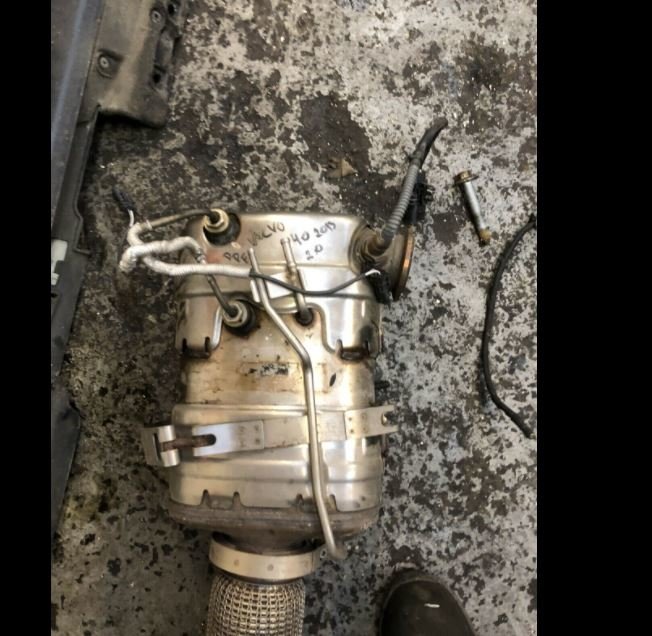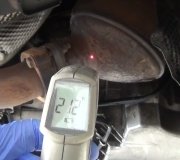Some more information.
Roy
The Diesel Particulate Filter
What is it?
European Emissions legislation is becoming progressively more stringent with regard to the level of emissions which vehicles are permitted to give off. Diesel fuel when burnt gives off a range of exhaust gases including sooty particles, or particulates, often visible on older diesel vehicles as black exhaust smoke.
Many diesel engines now require the addition of a diesel particulate filter to the exhaust system to comply with the emissions legislation.
A diesel particulate filter, or DPF, has a function similar to that of the catalytic convertor fitted to most petrol-engined cars. It is a device designed to remove diesel particulate matter or soot from the exhaust gas of a diesel engine. Wall-flow diesel particulate filters usually remove 85% or more of the soot, and can at times (heavily loaded condition) attain soot removal efficiencies of close to 100%. A diesel-powered vehicle equipped with a properly-functioning filter will emit no visible smoke from its exhaust pipe.
How does it work?
The DPF looks similar to a traditional exhaust silencer, but is mounted close to the engine. Inside is a complex honeycomb ceramic structure designed to filter the exhaust gases while minimising flow (which would otherwise limit performance). By forcing the exhaust gases through the walls between the channels of the DPF, the particulate matter is deposited on the walls, so reducing the amount of air pollution.
Does it require maintenance?
Any filter has a finite capacity, so diesel particulate filters must be cleaned out if they are not to block. This is most important, as an overfilled filter can damage the engine through excessive exhaust back pressure and can itself be damaged or destroyed.
When the DPF is becoming full, with around 80% load, it automatically cleans itself by initiating a process called regeneration. This process increases the temperature in the DPF and burns off the soot particles. To initiate regeneration, the DPF needs to reach and maintain a high exhaust temperature. This is normally achieved during motorway or higher speed driving. This "passive" regeneration occurs continually, and will go unnoticed by the driver.
Warning Sign In certain circumstances (e.G. Frequent short journeys or slow driving in congested areas), automatic regeneration may not be triggered. In this case, an amber warning light illuminates, with a message "soot filter full � see manual". The manual explains how regeneration can be initiated. When regeneration is complete, the message is cleared automatically.
It is important to take immediate action to regenerate the DPF. If regeneration is not achieved, soot will continue to build up, and the amber warning light will illuminate again, with a different message: "engine service required". The vehicle should then be taken to a dealer immediately for forced regeneration to be carried out. Failure to do so will cause difficulty in starting the engine, and may require complete replacement of the DPF.
Because smaller engines run at lower temperatures, a fuel additive may be required to promote regeneration. This additive, Eolys, is currently used on Volvo's 1.6 and some 2.0 diesel engines where a DPF is fitted. The additive is a cerium/iron based solution that is added to a special tank under the fuel tank, which holds approximately 1.8 litres. Additive consumption is low and the tank is topped up as part of the car's regular service schedule.
The fuel additive, whilst promoting regeneration to burn off soot particles, leaves a small ash residue which cannot be burnt off. It is therefore necessary to replace DPFs requiring the fuel additive at the 75,000 mile service interval.
Where the additive is not required, there is no need to change the DPF for the lifetime of the car, provided that regeneration is carried out as required.
Do I need one?
The fitment of a particulate filter to diesel-engined cars is becoming increasingly commonplace in order to meet emissions legislation and to achieve cleaner exhaust gases. Nevertheless, driving constraints in such locations as inner-city and islands (e.G. Channel Islands, Isle of Man) are unlikely to facilitate passive regeneration. Please consider your driving style and normal driving conditions to determine whether a diesel- or petrol-engined car is best suited to meet your needs. Your Volvo dealer will be pleased to assist you
Image (Click to make bigger)
Friday, January 15th, 2021 AT 1:41 PM



